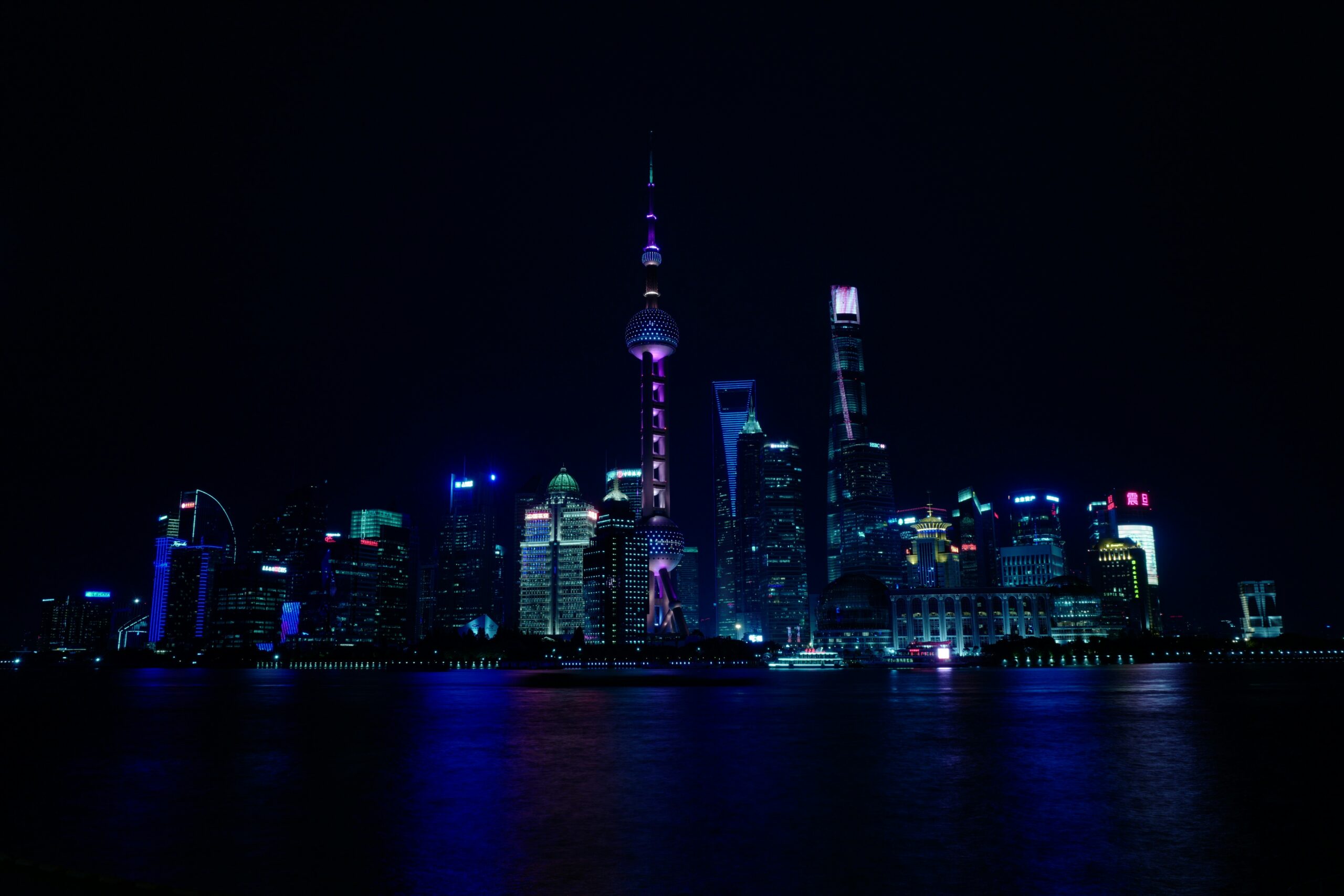In a future where water has colonized land, a team of crack scientists race to prevent a catastrophic breach in a major sea wall beyond the B-Harbor of Baltimore—but the effort will come at a cost.
Vera rotates her silent-running, fuel-cell powered skiff until she’s facing B-Harbor Sector 1. She comes to a full stop. After 15 years as a water stabilization specialist, this particular view still triggers a welcome twinge of joyous mystery, especially at night. The Twin Pyramids: the tips of two translucent triangles—one light, one dark—believed to have once been part of a museum for fish. It’s a miracle they’ve survived, after all that’s happened here. Hover-lights move in tandem with the rippling water, continually illuminating these glassy pyramids from above, reminiscent of how the North Star guided sailors in ancient times. From out here, what remains of the mainland, of solid soil, is out of view; B-Harbor, the commercial hub of Sector 1, is a tangled flow of hydro-highways, streams, and inlets, punctuated by irregularly shaped man-made structures of all sorts—beautiful ruins—whose origins and purposes are long forgotten. The past is an undiscovered country, Vera once read. All we can ever do, she thinks, is reinvent the past through the lens of the present—the only reality we truly know.
And what Vera knows, for sure, is that B-Harbor must be protected, at any cost. It’s the beating heart of the entire Baltimore Watershed—and the Atlantic Central Coastline’s undisputed center of power, commerce, and culture. With so much soil and shoreline lost over the last century—most of Delmarva, all of Annapolis, and so much more, including Hooper’s Island, Smith Island, Jane’s Island, Kent Island, Pasadena, Centerville, Crisfield, and Dundalk, just for starters—everyone in the mid-coast region has coalesced around Baltimore. Even Washington, D.C., has reverted to the uninhabitable swampland it once was. Nature, it seems, saw fit to restore Baltimore to its former colonial status as a bustling seaport. Vera appreciates the irony, even if the history of its people, their struggles and fates, are murky now.
To the west, Vera can just make out the shadowy contours and turquoise glow of the Camden Yards Aqua & Education Center. Vera spent countless hours there as a kid, studying hydrology and enviro-engineering with her peers, while also perfecting her backstroke and butterfly in the enormous bowl-shaped pool that Baltimore rightly claims as the largest, and best, on the Coastline. Vera could easily draw a map from memory of the rest of B-Harbor: The office and restaurant barges. The apartment towers rising atop extendable hydraulic pilings that remind her of a flock of black-winged stilt birds. And the tourist water-respites—barges tricked out to mimic old-fashioned land-based hotels, dotted with fake trees and grass.
But enough of this. If all goes as planned tonight, Baltimore will still be around in the morning, ready to be appreciated with fresh eyes. Vera forces herself to look away from home and turns the skiff toward the Keybridge Remnant. Thousands of hover-light beams form neat lanes arrayed across the open water as far as the eye can see. Ordinarily, these lanes are teeming with Sector-bound vessel traffic. But tonight, only essential personnel are permitted out here, and Vera, as the newly appointed Chief of Sector 1, is as essential as they come. Tonight, Vera’s sleek skiff is the only vessel generating any wake, and very little at that. She looks skyward: No stars. When are there ever stars? The hover-lights obscure the sky, laying down a carpet of white light as far as the human eye can see. Vera hasn’t seen stars since that long-ago night out at Deep Creek Lake, which is, after all, still a lake, bounded by soil. That glimpse of Orion’s Belt was astounding…but enough, she reminds herself again.
“Thea,” Vera calls to her AI-Mate. “Set a course for the coordinates where the initial breach is most likely to occur.”
“Course set,” Thea responds. “Bonner, Coffey, and Steiner are there now.”
“Thea,” Vera says, her body tensing because she already knows the answer to her next question. “Has the Council approved my request to put Sector 1 on high alert?”
“No,” Thea responds. “The Council’s most recent ruling, setting new speed limits for Class D skiffs, was issued 46 hours ago.”
Damn, Vera thinks. Damn their caution and complacency and trivial obsessions. It’s one thing to trust her and the Pod—Bonner, Coffey, and Steiner—to get the job done. But this isn’t just any job. And doesn’t the public have a right to know and a right to prepare for an emergency evacuation? Yet all anyone’s been told is that the hydro-lanes are closed tonight for routine maintenance. This isn’t right. It’s my home, too, Vera thinks, and my parents and my brother are just as much at risk. Yet the Council, in its infinite wisdom…Stop, she tells herself. Just stop.
Vera’s skiff picks up speed and makes a bee-line for Regional Hydropower Management System 3, roughly 75 nautical miles from B-Harbor Sector 1. This morning’s data indicated a 99.3 percent probability that RHM 3, the largest system of its series in Maryland, most of it looming four kilometers below the surface, is on the verge of breaking down. And if that happens, B-Harbor’s carefully integrated hydro-ecosystem will be rapidly overwhelmed, triggering a cascading failure of drinking water, stormwater, and wastewater treatment systems, which are regulated by an extensive AI network. In short, a total disaster. Technology only takes you so far in this world, as Vera and the Pod know well. Ultimately, nature wins. Humans, Vera thinks grimly, are lucky to come in a distant second. By this time tomorrow, second place had better look a lot like winning.
Vera pulls up alongside the coordinates of RHM 3’s surface-level sensor control unit. Bonner, Coffey, and Steiner, dressed in identical bio-wetgear suits, are standing together in a single, bobbing skiff. They could almost be triplets, with their shaved heads—by far, the most practical way to do water work. All three have the lean, hungry look of people who live on high alert. Ah, the Pod. The ones Vera counts on to read the tides, track the algae blooms and nutrient cycles, monitor the data, and even smell the roiling water with their very own noses. There’s still something to be said for the human factor. And for trust: the four of them grew up together on these waters, and, together, entered the ranks of top Coastline specialists. Vera could never have been tapped for chief without their unqualified support.
“Hail to the chief,” Bonner says.
“Very funny,” Vera says. “Where’s my suit?”
“Uh, Vere, you shouldn’t go down,” Coffey says.
“Oh, I’m going down,” Vera replies. “C’mon. My suit. We’re wasting time.”
“Think about it, Vera,” Steiner says. “You can’t implement and manage at the same time.”
“Seriously,” Bonner says. “We need you topside, working with Thea on the data as it comes in.”
“Thea can work with me anywhere, as you well know,” Vera says. “Besides, I cleared all this with the Council. I told them I had to see for myself. They wanted us to send the bots down alone, but I convinced them we need human eyes on this.”
“Which is why we are here,” Coffey says impatiently. “When are you gonna start acting like a chief?”
“When are you three gonna stop treating me like I’ve suddenly got two heads?” Vera snaps.
“What did I tell you?” Steiner says to Bonner and Coffey, as the three exchange a knowing look.
“OK, OK, I get it,” Vera says. “But you know I hate being sidelined. Why should I miss all the fun?”
“Look,” Steiner says, “you’ve got a job to do, and so do we.”
“We’re still the Pod,” says Bonner.
“Still joined at the hip, like it or not,” Coffey says, rolling their eyes.
“Womb to tomb,” Vera says, smiling. There’s nobody she’d rather be in the soup with right now. “But I’m not kidding. Give me a bio-suit.”
“No,” comes the unison response.
Thea cuts off further debate: “Optimal dive and inspection time begins in four minutes and 16 seconds,” the AI-Mate says, for everyone to hear. “Time to RHM 3 failure is now seven hours, 32 minutes, and 11 seconds.”
“Thea, what’s the current probability of failure?” Vera asks.
“Sensor data indicates probable failure has risen to point nine-nine-six,” Thea responds.
“It’s go time,” Vera says. When she was six, Vera watched a holo-story about a boy who put his finger in a dike—a defensive seawall, she thought, even then—to keep the waters from engulfing the boy’s village. That image, of water ready to morph from the stuff of everyday life into a life-threatening weapon, has been with her ever since. And she knows, deep down, it’s why she is where she is this very minute.
The Pod plunges overboard and Vera activates her bio-vest—a highly calibrated sensor-capture garment that keeps her warm on a cold night over open water, while filtering all the relevant data she needs to keep on top of the situation as it evolves. She looks out across the lane of hover-lights that vanish from view as they stretch back toward home, toward B-Harbor. Thousands of families in their stilt-raised apartments, relaxed and unaware, are tucking their children into bed, while tourists settle onto artificially turfed patios, sipping cocktails. Vera imagines her younger brother Geoff enveloped by a holo-movie, completely unaware that tonight, everything could go wrong. Where are the Council’s priorities? Vera wonders, shaking her head.
For the next several hours, Vera casts politics aside, as she and the Pod, working in tandem with focus on identifying the cause of the impending breach—whether the problem is structural or a rare network error—and figuring out how to stop it before passing the point of no return. From her skiff on the surface, all is calm: the night is cold and clear, illuminated only by the hover-lights beaming across the water as it slaps the boat. Thea projects a holographic image above the bow, so Vera can follow Bonner, Coffey, and Steiner as they fan out to inspect each centimeter of the hulking RHM 3, its murky bulk looking something like a sunken treasure ship.
“Not to rub it in,” Bonner says from below, “but it’s a beautiful night down here.”
“Which is worrisome,” Coffey adds. “What are we missing?”
“Time check?” Steiner asks.
“Two hours, 47 minutes to probable failure,” Thea reports.
“Check the heat sensors again,” Vera says. Hundreds of temperature sensors are embedded in the titanium-Q exterior of RHM 3 as a way to help stabilize turbidity and other factors that could stress the carefully calibrated ecosystem surrounding B-Harbor, and by extension, all of Sector 1.
“I detect no sensor anomalies outside of normal tolerances,” Thea says.
“Visual, tactile, and instrument inspections reveal nothing out of the ordinary. Nada!” says Steiner, clearly frustrated. Bonner traces a question mark in the water. Vera looks up into the night sky, wishing that just one star would poke through. This whole situation doesn’t make sense. If this infrastructure fails—for whatever reason—a flood of pathogens, chemicals, and algal toxins will invade the life-support systems at B-Harbor with an overpowering whoosh. And Vera cannot imagine allowing that to happen on her watch; she cannot imagine a world without Baltimore, which for centuries has fought off enemies from outside and inside its own borders, always managing to reinvent itself as a stronger, better, more dynamic metropolis each time. Including this time.
She has a sudden thought. What if there’s nothing wrong with RHM 3? What if the problem lies with Thea? Technology: infallible until it’s not. “Thea,” she says, “run a self-diagnostic on your own diagnostics.”
“Good idea,” says Coffey from below. “We’re running out of ideas.”
“And time,” Bonner says.
“Thanks, Captain Obvious,” Steiner adds. “Seriously, though. We’ve cross-checked all our calibrations, and everything seems to be working.”
“You must be tired,” Vera says. “Come on back.”
“Vera, I think we should stay below until we figure out what’s going on,” Bonner says.
“Hey, Bonner,” says Vera. “I’m the one with two heads, remember? I’m not asking.”
“OK, tyrant,” says Coffey.
“Lord and master,” adds Steiner.
“Hah-hah,” Vera says.
“Self-diagnostic protocol review completed,” Thea reports. “No internal malfunctions are reported.”
That settles it. The Pod resurfaces together and boards Vera’s skiff. The four of them hug, wordlessly, the bio-suits dripping onto the shallow deck. “Stow your wet gear here, jump back into your skiff, and take a breath,” Vera says. “You’ve done all you can.” They nod, their faces drained with exhaustion. The bio-suits’ advanced breathing ports let you remain underwater for up to 24 hours, but human energy still has its limits. While the others are busy regrouping in their own skiff, Vera quickly and quietly replaces her bio-vest with one of the discarded bio-suits, still wet on the outside, warm on the inside. As she tilts backward into the water with a small splash, she sees the first sliver of pink morning light on the eastern horizon.
“Sector 1 chief is zero point five kilometers below the surface and descending,” Thea reports.
“No, no, no, no,” says Coffey.
“She’s going to do something rash,” Steiner says.
“Not rash, stupid,” says Bonner.
“This is like that time she dared us to take our skiffs over the Grand Waterfall, out by Cunningham,” Coffey says.
“That was really, really stupid.”
“And if we hadn’t been there…,” Steiner adds. The three stand in the bobbing skiff, each deciding just how far Vera will go, right now, to find whatever it is they’ve all been searching for all night.
“She doesn’t trust you, Thea,” says Bonner.
“What about us?” Steiner says. “Why can’t she—”
“Thea, show us Sector 1 chief,” Coffey says. Thea projects a holo-view of Vera, heading rapidly toward RHM 3, propulsion bubbles streaming behind her.
“So friggin’ arrogant,” Steiner says. “It’s not our fault if—”
“Shut up,” Bonner says.
Vera is now abreast of RHM 3. Right about now, they’re telling each other I’m an idiot. Or arrogant. Or both. But deep down, they know that’s not it. After all, it’s our home.
Vera rapidly surveys the area adjacent to RHM 3 that she knows her colleagues—and Thea—have scoured. The answer isn’t here. She doesn’t think she’s smarter. Definitely not. Actually, she suspects she might be more sentimental. About saving B-Harbor. And Baltimore. And all of Sector 1. Or even just Geoff. And they all distrust sentiment. Feelings. Because, after all, their primary shared language is science. But I speak both.
“Where’s she going?” Steiner asks.
“Wherever it is, we’ve already been there,” Bonney says.
“Thea,” Steiner says. “Thea.” But they don’t know what to ask, what’s left to ask, what they, let alone Thea, or Bonner and Coffey, can say that will protect or even save Vera, if it comes to that.
“You know she’s gonna do what she’s gonna do,” Coffey says, rubbing Steiner’s shoulders. The Pod stands there, unsure how to help their friend and leader.
“Sector 1 chief has arrived at RHM 3,” Thea reports. The Pod watches the holo-projection over the bow, the dawn just barely beginning to illuminate the scene.
“Time to failure?” Vera’s first words since her descent.
“Thea, don’t—” Bonner says.
“Thirty minutes and 52 seconds,” Thea responds, because that’s what she does.
Vera scans the enormous, irregular circumference of RHM 3 and feels her ways along its walls, looking for anything, any anomaly, that might solve this puzzle. And then she sees something: a shadowy darkness, darker than the surrounding water, yet not entirely dark, as if something is moving, creating a deep-water disturbance within a slim crevice between adjoining segments of this life-saving beast. There. It must be there.
Vera pokes her arm into the narrow crevice, and her arm is instantly populated with dozens of brief squids—gelatinous, translucent creatures, with a spray of black specks on their broad little backs.
“What’s happening?” Bonner asks, peering at the holo-projection. But Vera already knows—or thinks she does. The brief squid, a small mollusk, was once a warm-water bottom-dweller in the lower Chesapeake. But after a century of climate change, the creature’s habitat has expanded as the waters have warmed. And the little squids have thrived—aggressively. The little monsters love the warmth radiating from the walls of RHM 3, and who could blame them? Vera calmly withdraws her bio-suited arm and regards the brief squids with respect and even a bit of affection. And then it hits her: the brief squids have massed on RHM 3 as if it were an electric blanket on a cold winter night, to the point where they’ve absorbed, as a group, a significant percentage of the sensor heat, leaving the titanium-Q exposed to the actual elements. And that’s the source of confusion right there: RHM 3’s surface is increasingly brittle, but the little squids fool the sensors—and Thea—because as little heat-seeking missiles, they’ve remained glued to the wall’s surface. So the readings are just fine. But all the heat is being siphoned away.
“Vera, we see them,” says Coffey. “But—”
“They’re beside the point,” Bonner jumps in.
“No,” Vera says. “They are the point.”
“Time to failure is nine minutes and forty-five seconds,” Thea says.
“What are you—?” Steiner says.
“Trust me on this,” Vera says. “I’ll be top-side in five minutes.”
Vera’s plan is simple. Her bio-suit is warmer than the water, and the brief squids are driven by instinct. If she can siphon off enough of them—get them to follow her—the RHM 3 settings should return to normal. Vera sidles as much of her body into the crevice as she can, which disturbs the colony of brief squids hugging RHM 3. That minor disturbance persuades enough of them to migrate to Vera’s bio-suit. Very quickly—more quickly than she anticipates—Vera is bloated with the translucent creatures; they hug every inch of her, in overlapping layers, as if their lives depended on it. Slowly, Vera propels herself out of the crevice. Her vision is obscured by the squids adhered to her bio-mask. Her arms and legs are unexpectedly heavy with the weight of so many small creatures. Her plan seems to be working, but it’s harder than she anticipated.
“I get it,” Coffey says, as the three of them follow Vera’s movements. “Thea, program RHM 3 external sensors to emit a low-voltage charge when anything comes in contact with the titanium-Q.”
“Brilliant, Coffey,” Vera says. “That’s what I’m talkin’ about.”
“RHM 3 structural integrity is stabilizing,” Thea reports.
“Teamwork!” shouts Bonner to the open sea.
“Sector 1 chief has just entered Depth Level 4,” Thea continues. “Her metabolics are exceeding recommended parameters.”
“Wait. She’s sinking,” Bonner says, alarmed. “The electric shock sent the rest of the squids scurrying for warmth—and she’s it.”
“She didn’t count on the squids’ water weight,” Steiner says. “It’s overwhelming her suit propulsion.”
“We have to do something!” Bonner says.
“You and I will go after her,” Steiner says. “Coffey, work with Thea.”
“Your bio-suit propulsion systems are not capable of overtaking Section 1 chief at current rates of descent,” Thea says.
“Then what the eff do you propose?!” Coffey asks. “Options?!”
“Vera!” Coffey, Bonner, and Steiner shout together. They all hang a moment in cold silence, as the pink of morning emerges.
“I’m going over the Grand Waterfall, after all, guys,” Vera says, her voice sounding far away. “Guess you couldn’t stop me.”
“Thea! Display Vera’s life support systems,” Steiner says. Thea complies. They stare at the holo-display, as if their own lives depend on the readings.
“Oxygen sufficient for 19 hours,” Thea reports. “But suit pressurization is failing.”
“No more failing!” Coffey yells.
“No more complaining,” comes the increasingly faint reply from Vera. “Protect our harbor.”
“Thea! Options!” Bonner yells.
“Evaluating recovery scenarios,” Thea replies.
“We’re not talking about recovery, Thea!” Steiner says, their voice rising in pitch. “We’re talking about rescue! What’s wrong with you!”
“Tell Geoff I love him,” Vera says. “It’s beautiful here. But it’s not Baltimore.” The clouds as they shape-shift across B-Harbor, skittered by the wind. The water as it glitters and ripples in sunlight. Knowing that the city will survive to become its next best self, on water or on land, it doesn’t matter. I only wanted to help keep it all going. Just wish I could see what happens next.
Thea pilots both skiffs back to B-Harbor as Bonner, Coffey, and Steiner slouch in stunned silence. The morning sun glints on the water and is reflected off the hard surfaces of the Harbor-bound vessels crowding toward the docks, now that the Council has re-opened the traffic lanes. By the time the Pod reach the dock, children are being ferried, noisily, to their school barges. The tourists are setting off on guided tours of B-Harbor. And Baltimore is back in business, for another day, at least.




